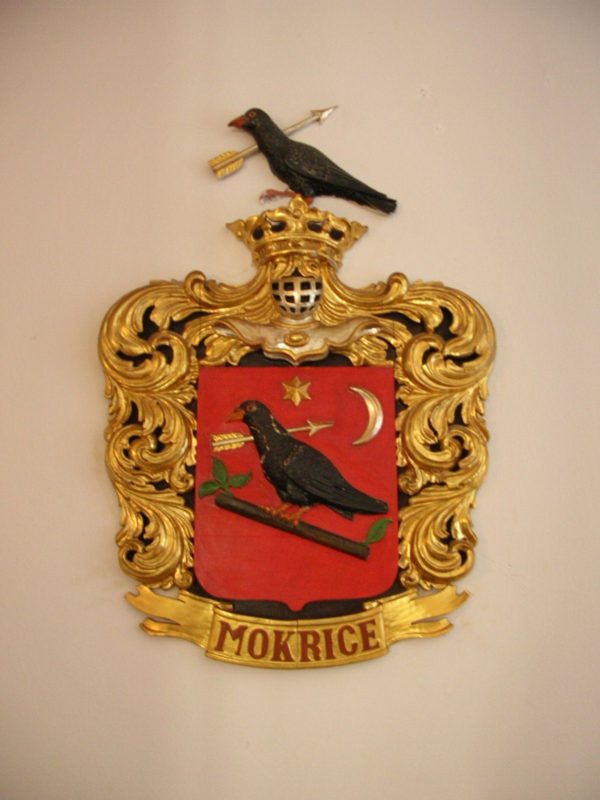
Coat of arms of hte Gregorijanec family in Mokrice Castle
MOKRICE, CASTLE
Location of the coat of arms: façade
Beside the inscription Hotel Grad Mokrice above the main entrance to Mokrice Castle (formerly Mokritz), the visitor is now also greeted by a coat of arms depicting a raven against the red background with an arrow piercing through its neck. The coat of arms once belonged to the Gregorijanec family, which owned the castle in the sixteenth and seventeenth centuries. Albeit of Croatian origin, the family had close ties to what is now Slovenian territory, not only through Mokrice but also as one of the key players in the famous Croatian-Slovenian peasant uprising of 1573.
The origins of the Gregorijanec family are not entirely clear. Historians search for their roots in the Križevci (Hun. Kőrös) County. The first known member of the family was most probably Gergely, whom King Sigismund granted a fortification in 1427. The family can then continuously be traced for no more than a century through György Gregoryancz, a learned lawyer, documented in 1520 as the protonotary of Slavonia. Both his sons were famous personalities in their days. Pál (died in 1565) was a theologian, historian, and Latinist; in 1550, he was consecrated as Bishop of Zagreb, then also as Bishop of Győr (1554), and ultimately as Archbishop of Kalocsa (1565).
His brother Ambrus (died in 1572) wrote himself into history in an entirely different manner. A man of letters himself, referred to in sources as literatus, he was in the service of the Princes Zrínyi and in 1541 appointed as the military commander (captain) in Turopolje. His military career enabled him to accumulate great wealth, also in the form of estates in the Zagreb and Križevci counties. Between 1544 and 1556, he served as the provincial war tax collector (dicator) of the Kingdom of Slavonia, and in 1558 he obtained the title of vice ban while holding the office as the mayor of the Križevci and Zagreb counties.
Land acquisitions also led Ambrus Gregorijanec to the territory of modern Slovenia, where he purchased a part of the Mokrice seigniory in 1558 and the rest of it in the following two years. His family settled in Mokrice for a little less than a century. Ambrus remodeled the tower-shaped building, which formerly served as a court, by giving it the appearance of a Renaissance castle. In memory of the restoration work done, he had his heraldic plaque built into the façade above the castle portal in 1562. The current location of the plaque is unknown. What is known, however, is that it depicted the Gregorijanec coat of arms—a raven with an arrow in its neck.
According to the legend, the origin of the Gregorijanec family coat of arms is associated with the Turkish incursions: ravens were believed to warn of the nearing Turkish troops. When a Turkish arrow hit one of the ravens in the neck, the bird still managed to fly to Mokrice Castle and warn the family of the imminent threat. However, the legend does not hold because the family already had such a coat of arms before arriving in Mokrice.
The last decade of Ambrus Gregorijanec’s life was predominantly marked by his disputes with Ferenc Tahy (Croatianized: Franjo Tahi), which culminated in the major Croatian-Slovenian uprising of 1573. The dispute cost Ambrus his title of vice ban in 1566 and a significant part of his estate. He died in April 1572, presumably in Mokrice. His great-granddaughters Marta and Ana Maria were the last owners of Mokrice from the Gregorijanec family. After their deaths, the seigniory and the castle passed into the hands of their relative Jobst Josef Baron von Moscon.
Sources:
Preinfalk, Miha: Plemiške rodbine na Slovenskem. 16. stoletje. 1. del – Od Barbov do Zetschkerjev. Ljubljana, 2017, pp. 109–114.
